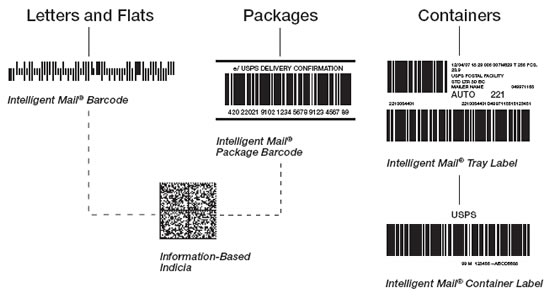Chapter 4 Our Operations
Total Mail Visibility
INTELLIGENT MAIL
For more than 20 years, barcodes have been at the core of advances in postal quality and productivity. Automated mail processing, driven by barcodes, allowed the Postal Service to reduce costs as it delivered more rapid, reliable, and consistent service. With the September 2006 introduction of the new, high-capacity Intelligent Mail (IM) barcode, the Postal Service and its customers began to take the next step in automation — the transition to Intelligent Mail.
Intelligent Mail is a comprehensive term that describes the integration of electronic mailing documentation, intelligent barcodes on mail and containers, and in-process scans to track mail from origin to destination. Mail containing the IM barcode will be tracked continuously throughout the system, creating new opportunities to improve service consistency, efficiency, and value.
Mailers of letters and flats can now qualify for automation discounts solely by using an IM barcode or with Intelligent Mail services. By the end of the year nearly 200 mailers have begun using the IM barcode and OneCode Services, including OneCode Confirm and OneCode Address Change Service (ACS), and are seeing improved data control that enhances their address hygiene and barcode quality efforts.
Customer outreach continues to expand the number of users. Intelligent Mail workshops have been conducted at 200 PCCs, reaching more than 13,000 mailers. Simplified mail acceptance processes using IM barcodes are being tested in First-Class Mail and Standard Mail pilots.
Tests conducted in 2007 by the Postal Service and flat-sized mail vendors addressed many questions related to IM barcode printing specifications. As a result, the Postal Service revised its print specifications in September. The Postal Service has also made IM barcode encoder software available to support customer mailing systems and ease mailer conversion to the new code. For decoding, a barcode reader or software is required. An online solution is available on the Rapid Information Bulletin Board System (RIBBS) Web site for manual low-volume barcode encoding and decoding.
Intelligent Mail Infrastructure
The ability to perform passive in-process scans on letter automation equipment is already in place. The capability for passive scans on flat mail is near completion. With a final upgrade scheduled for February 2008, in-process scanning of letters, cards, and flats will be enabled throughout the network.
The backbone of automated processing is a local area network (LAN) at each plant. The LAN is the conduit for downloading ZIP Code directories and sort plans to processing equipment, transmitting individual mailpiece images for resolution, and consolidating tracking data to computer servers. In 2007 the Postal Service completed its LAN replacement deployment program known as Mail Processing Infrastructure, having upgraded 158 plants and eight remote encoding centers.
The infrastructure to provide package and bundle visibility is coming into place. Shipment Confirmation Acceptance Notice procedures were initiated in November 2006 to provide an acceptance scan event and allow service measurement for Package Pickup. The Automated Postal Center, Click-N-Ship, and mailer applications were enhanced to enable them to print the IM package barcode.
Scanning at Post Office retail terminals and by more than 300,000 hand-held Intelligent Mail scanners provide “start-the-clock” data at acceptance and “stop-the-clock” data upon delivery. Upgrades to 74 automated package processing systems and 215 small parcel and bundle sorter systems enabled enroute package and bundle scans.
